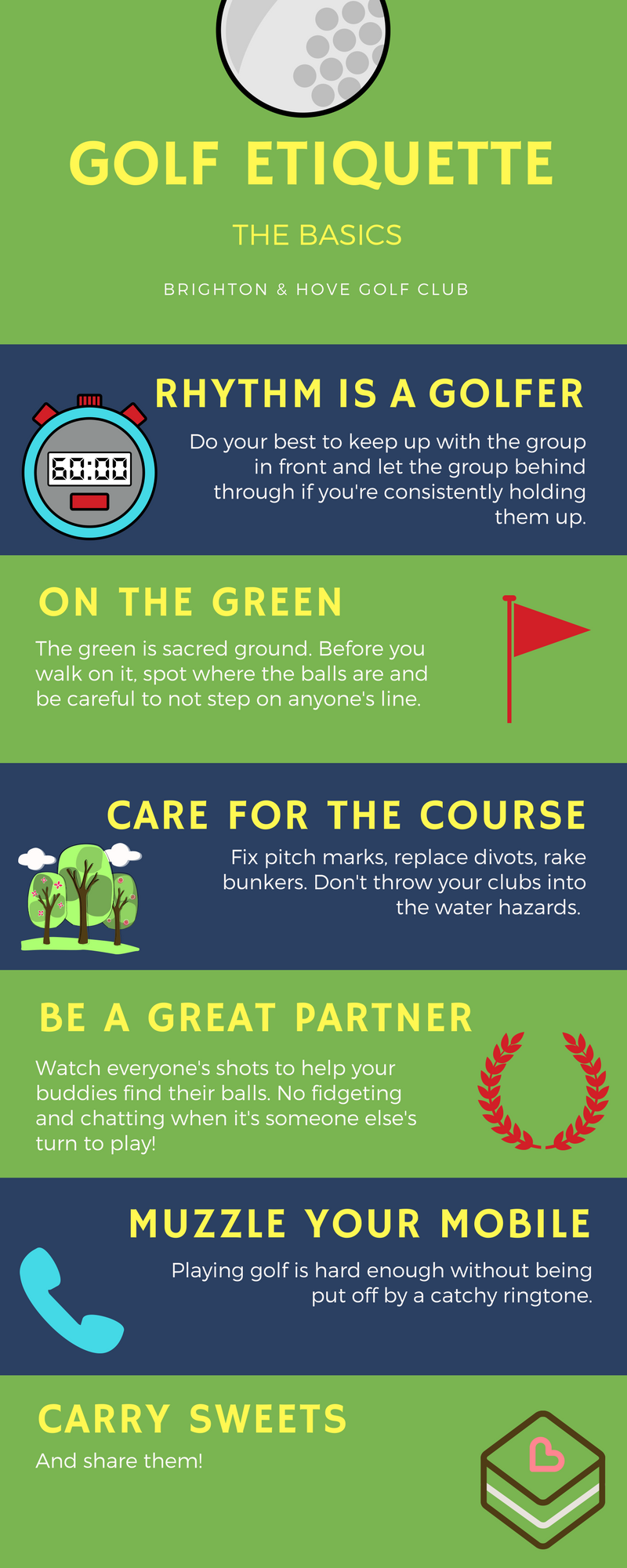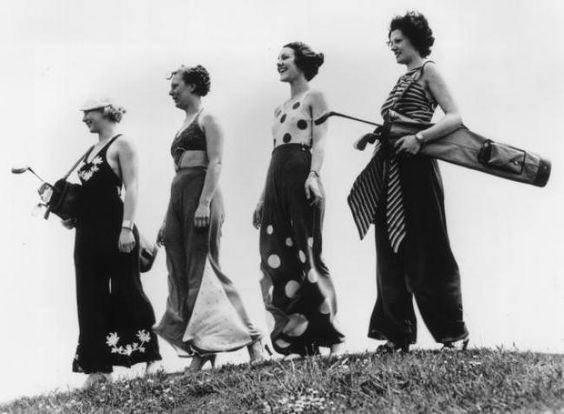
by Céline | May 12, 2018 | Competitions, Rules

Coming up the 9th fairway
This past Thursday, my partner Jo & I played in the third round of the Daily Mail Foursomes, a national match play competition. We were playing against our good friends and neighbours Pyecombe Golf Club in wonderful conditions. The match was close and on the 4th hole, after missing her putt and halving the hole with us, our opponent put a ball down and putted again. “Be careful,” I said. “You’re not allowed to practice your putting on the front 9.” “Really? It must be a local rule”, she replied. “It’s a 9 hole course rule. As we’re going to play this hole again, this is similar to testing the green”, I said. In our women’s section, we often remind each other of that rule, as it’s so easy to forget. They asked us if we wanted to claim the hole because of the unlawful practice stroke, and of course we said no. We halved the hole.
When I got home, I thought I’d check the exact ruling. To my horror, even though I combed the whole entire golf rules-related internet and beyond, I couldn’t find anything that confirmed my oh so very confident assertion. The relevant ruling reads as follows:
Rule 7-2 – Practice during a round
Between the play of two holes a player must not make a practice stroke, except that she may practise putting or chipping on or near:
a. the putting green of the hole last played,
b. any practice putting green, or
c. the teeing ground of the next hole to be played in the round, provided a practice stroke is not made from a hazard and does not unduly delay play.

On to the 4th round of the Daily Mail Foursomes!
I even checked all the 15 decisions mentioned on the R&A website, and I found nothing. I talked to our pro and he explained that even though the 4th and the 13th holes share the same green on a 9 hole course, they are both considered two distinct holes. Thus, practicing on the 4th isn’t tantamount to testing the 13th green. How come everyone in our section thinks otherwise?
So, Lorraine, I’m very sorry that I told you the wrong rule, but there was no doubt in my mind. And I’m really, really glad we didn’t claim the hole! I will clarify this in our women’s section’s next newsletter – this particular 9 hole course myth must be dispelled.

by Céline | Dec 1, 2017 | Rules
Hi! It’s been quiet around here, hasn’t it. It’s been nice taking a break from captaining and golf responsibilities. I’ve been using my extra free time constructively to expand my work options, including by taking a course on design. I’ve loved it and as a practice, I’ve put together an infographic for the women’s section. We’ll be using it in the new year, when we have workshops to help our new members learn about various golf-related things. One of them will be etiquette.
The more I play, the more I realise how important golf etiquette is. This is how the R&A defines it:
Etiquette is an integral part of the game, defining golf’s core values. It describes the manner in which the game of golf should be played to ensure all players gain maximum enjoyment.
In short, it’s about “respect”:
- Respect for the course – leave the course as you would like to find it by repairing pitch-marks, replacing divots and raking bunkers
- Respect for your fellow players – be sportsmanlike and polite, stay by the green to watch them hole out, and avoid distracting them
- Respect for the game – by knowing the Rules and etiquette of golf
R&A website
In a sport where you share the playing ground with various other people, a common set of accepted behaviours can make the difference between having the best fun ever and experiencing a world of frustration. That is what golf etiquette is. I put together the main pointers I think any golfer, new or old, should keep in mind to make everyone enjoys their round. Let me know what you think!


by Céline | Oct 23, 2017 | Rules

Staying on the perch is tough
One of the great joys of golf is the endless variety of games and formats it allows. Indeed, what’s a game of golf without some healthy competition and endless arguments over who gets to buy the drinks at the end? For two golfers, my favourite is match play, but when there are three of you, I like the following formats:
On the perch
The aim of the game is mainly to pretend you understand the game, as nobody’s really sure how it works. I’ll try to explain my take on it. The aim is to win points and for that, you first need to get on the perch by winning a hole outright. Once you’re on the perch, you then need to win the next hole outright to win a point. If you’re on the perch and halve the next hole, you stay on the perch BUT you don’t win a point. On the other hand, if another player wins the hole outright, you get knocked off the perch and that player takes your place. If the other two players halve the whole, you get knocked off the perch, which is now empty. This format is so complicated that it doubles up as a test of friendship. Much fun.
Bingo, bango, bongo
To win points, you have to be the first to do something: reach the green (bingo), get closest to the pin (bango) and hole out (bongo). Each accomplishment wins you one point, so three points per hole are up to grabs. This is a great game for a group of players with different skill levels. Stronger players will have a better chance at getting to the green first, but a higher handicapper will have every chance of getting close to the pin first, regardless of how many shot it took her to get there.
Snake
This is all about the putting, the aim of the game being to not end up with the snake at the end. Each time a player three-putts, that person picks up the snake and a pre agreed amount goes into the pot. The snake gets passed on to whoever three-putts next. The player who holds the snake at the end of the round pays out the pot to each opponent. No gimmies allowed!
Further reading: Ten great golf gambling games

by Céline | Aug 1, 2017 | Rules

Seriously?
A spot of bother with a water hazard
I mean, look at that. What’s a golfer supposed to do here? Is the hazard margin part of the pond or not? Are we in a tennis situation, where the line is part of the court? Or is it like football, where the whole of the ball needs to have crossed the line to be deemed off the pitch?
I wasn’t sure, so to avoid any trouble, I took the safe option. I assumed that my ball being on the hazard margin was bad news and I didn’t ground my club. Well done me:
Section 2 – Definitions
When the margin of a water hazard is defined by stakes, the stakes are inside the water hazard, and the margin of the hazard is defined by the nearest outside points of the stakes at ground level. When both stakes and lines are used to indicate a water hazard, the stakes identify the hazard and the lines define the hazard margin. When the margin of a water hazard is defined by a line on the ground, the line itself is in the water hazard. The margin of a water hazard extends vertically upwards and downwards.
A ball is in a water hazard when it lies in or any part of it touches the water hazard.
Excuse me?
“The margin of a water hazard extends vertically upwards and downwards”
What on sweet mother Earth does that mean? The only situation I could envisage where this would be relevant is if gravity suddenly stopped working and my ball hovered over the hazard. I looked this up, and it appears that this covers the case where a ball is lodged in a tree above a water hazard. If it is within the hazard margin, it is considered to be in the hazard. That means you can drop it behind the hazard with a one shot penalty. But downwards? In what reality-bending Boris Vian world would that rule be applied? Answer: it’s to do with bunnies. Keep reading…

Not enough cute rabbit photos on this site, if you ask me
Bunkers
Bunkers are different: they extend downwards, but not upwards, so you’re ok if your ball is caught in a branch over a bunker. This is where bunnies come out to play. Imagine that your ball rolls into a rabbit hole and you can see that it’s gone past the margin of the bunker. This means that your ball is no longer in the bunker. You get free relief and the reference point is the spot on the ground directly above the ball. If your ball is in the hole, but within the margin, it is deemed to be in the bunker, as the margin extends downwards. You can then take a free drop, but it has to be inside the bunker.
Ground under repair
Patches of ground under repair are like bunkers: they extend downwards, but not upwards. This means that you can take relief from the branch of a tree growing within the ground under repair margin if it impedes your swing, even if the branch is outside the line. However, you can’t take free relief from the roots of a tree growing within the GUR margin, because the margin extends downwards, which means that anything below the ground is outside the GUR.
So there you go. How’s your headache? During my research, I discovered the incredible resource that is Ask Linda. Linda is basically the Queen of Golf Rules. It appears that there is nothing she doesn’t know. How have I survived so far without her wisdom?

by Céline | Jul 20, 2017 | Pro(per) golfers, Rules

Nice try ladies, but too much plunging going on
I never wanted to play golf. For months, my friend Katie tried to convince me to join her in taking lessons, and my answer was always the same: “I’m a football player. I’m not a golfer.” I just didn’t see how I could belong in a world that seemed to offer a heady mixture of racism, elitism and sexism. From a distance, all I could see were barriers, especially golf’s obsession for rules and regulations, including a strict dress code. As a woman who doesn’t like being told what to wear in her free time, this was enough to put me off even trying golf. I know I’m not the only one feeling this way. Golf suffers from an image problem, especially amongst young people, so I was intrigued when the LPGA (Ladies’ Professional Golf Association) decided to update their dress code. Violations will be met with a $1000 fine.
- Racerback with a mock or regular collar are allowed (no collar = no racerback)
- Plunging necklines are NOT allowed
- Leggings, unless under a skort or shorts, are NOT allowed
- Length of skirt, skort, and shorts MUST be long enough to not see your bottom area (even if covered by under shorts) at any time, standing or bent over.
So certain items of clothing are NOT allowed, while others MUST be long enough. The problem I have with this is twofold:
1) It is confusing. What exactly is a “plunging neckline”? Where does the “bottom area” end and where does it start?
2) Who will be in charge of enforcing it? Do they need to provide their own measuring tape?
3) Say your skirt is of acceptable length, but a sudden gust blows it up and reveals part of your “bottom area”. Does the course architect get fined for creating a wind tunnel?
4) Why does golf have such a problem with the female body, when other sports seem to embrace it? Have you ever heard of swimmers, sprinters and long jumpers being reprimanded for showing too much skin?
5) I could go on, but I said my problem is twofold and I’ve already gone on too much.

Ties should absolutely be compulsory. Love this.
All Tour professionals are athletes. They are amazing ambassadors for golf. I find it so embarrassing that they’re shamed in such a way. Their goal is to win tournaments and they have to feel comfortable and confident to play as well as they can. For some of them, that means wearing modern pieces of clothing that are cut differently from the traditional golf outfits. They’re young women; of course they’re going to have different tastes from our venerable elders. Is that really such a big problem? Is it so offensive to see a woman’s collarbones on the course? How is that harming the sport?
I understand that for some people, the dress code is a way to maintain certain standards of behaviour on the golf course. I would argue that some of the rudest people I’ve come across adhere strictly to the dress code. To me, dress code and behaviour have very little to do with each other. This change looks more like a knee-jerk reaction of an old-fashioned establishment trying to control their younger and more modern members. But the worst thing is that it was widely shared and publicised, which is horrible for the image of a sport which is trying to modernise itself in order to attract the young players it needs to survive.
This change of dress code has achieved one thing: confirming the reputation of golf as hopelessly old-fashioned and sexist. As a football player, I know an own goal when I see one. This one is spectacular.

Ladies and gentlemen, we have a winner!

by Céline | Jun 5, 2017 | Rules
At Brighton & Hove, we have this really nice competition called the Burt Brill foursomes. Players are put in two groups, higher and lower handicappers, and pairs are drawn together so that a higher handicapper plays with a lower handicapper. And off they go, playing alternate shots to get around the course as efficiently as possible. I expect most clubs have a similar competition. It’s one of the big ones, where you get your name on a board, so I really want to win it. I’m not doing too well though, as we played it on Wednesday and I was disqualified for the second year in a row. For the same reason. On the same hole. Live and learn, you say? I wish.

One bucolic scene, two identical golf crimes
This is what happened last year: in the foursomes format, you take turn hitting the ball and one player tees off on even holes and the other on odd holes. I was teeing off on odd holes and my partner Angela on evens. All was well until we arrived on the 8th and I kinda forgot about the whole alternate thing and teed off. Neither Angela nor our playing partners noticed that I played out of turn and we finished the hole. It’s only when we got to the 9th tee that I realised Angela should have teed off. What to do? Nobody knew. We agreed that we’d go in and ask Anthony on the turn. Maybe we’d be allowed to play it again later?
This year, the mistake happened on the 8th green. My partner missed her putt by millimetres and out of sheer frustration, she knocked it in, playing twice in a row. Again, we were all flummoxed. Again, we agreed to go and talk to Anthony at the turn, but we thought it might be a two stroke penalty for playing out of turn. This reminded me of what happened the year before and I suspected we were probably disqualified.
If only I had a well-functioning memory, then I would have remembered what Anthony told us last year. When you play out of turn in foursomes, the player who should have taken the shot plays it again, from the same spot, and the game carries on. The team suffers a two stroke penalty. You have the option of correcting your mistake until you tee off on the next hole. So last year, when we realised my mistake after finishing the hole, we should have gone back to the 8th tee to play the hole again in the correct order. This year, I should have put the ball back where it was when my partner hit it out of turn and carried on playing. In both cases, we would have had a two stroke penalty, but we wouldn’t have been disqualified.
This is covered by rule 29-3:
If the partners make a stroke or strokes in incorrect order, such stroke or strokes are cancelled and the side incurs a penalty of two strokes. The side must correct the error by playing a ball in correct order as nearly as possible at the spot from which it first played in incorrect order (see Rule 20-5). If the side makes a stroke on the next teeing ground without first correcting the error or, in the case of the last hole of the round, leaves the putting green without declaring its intention to correct the error, the side is disqualified.
Will I remember this? I’m not hopeful. Come back in a year to see if I’ve made it three in a row!















